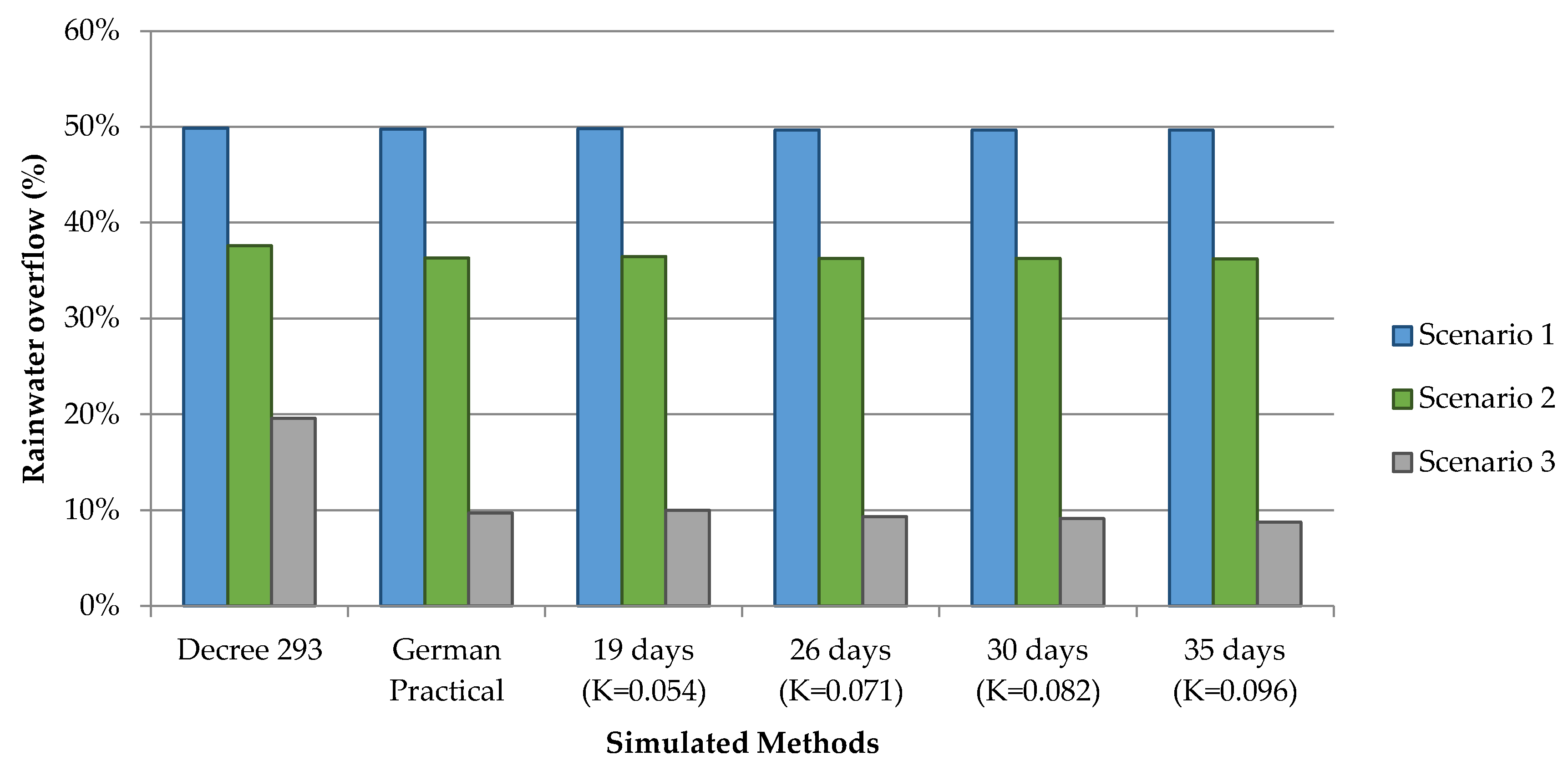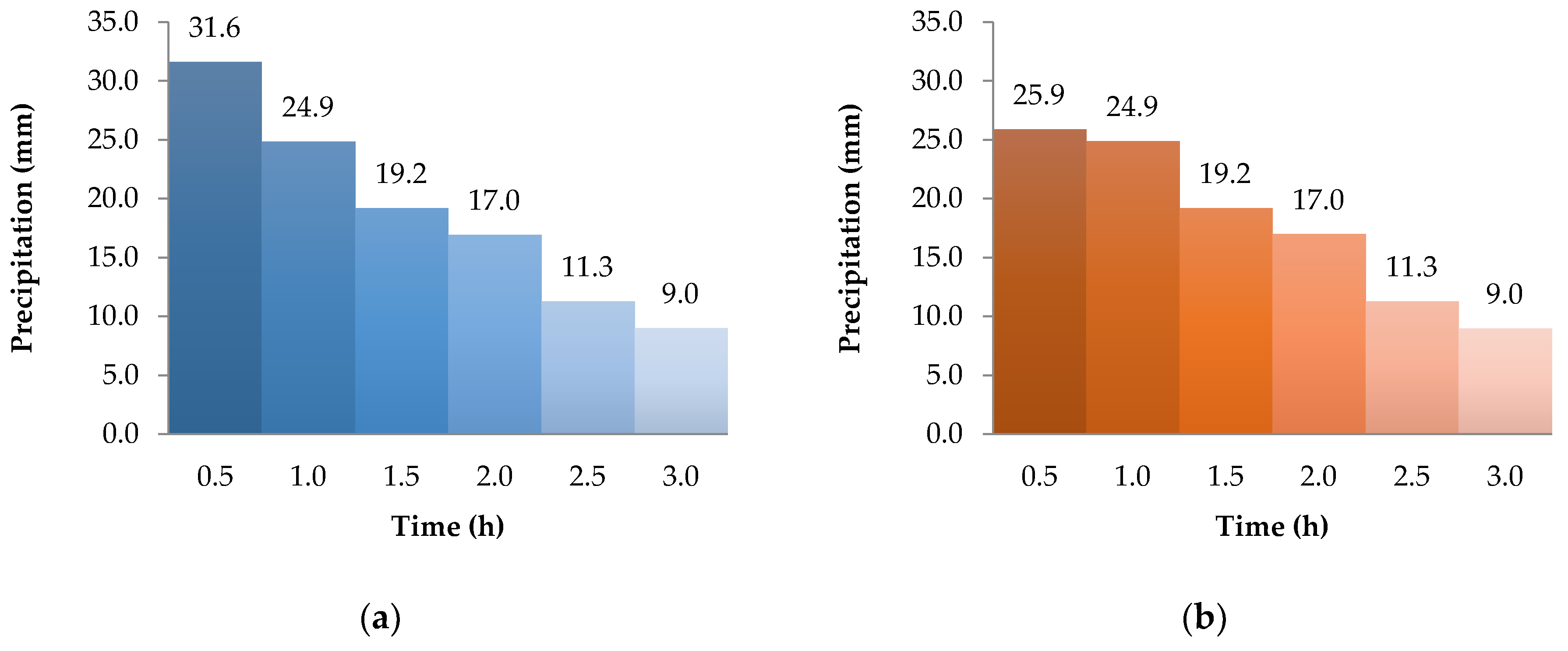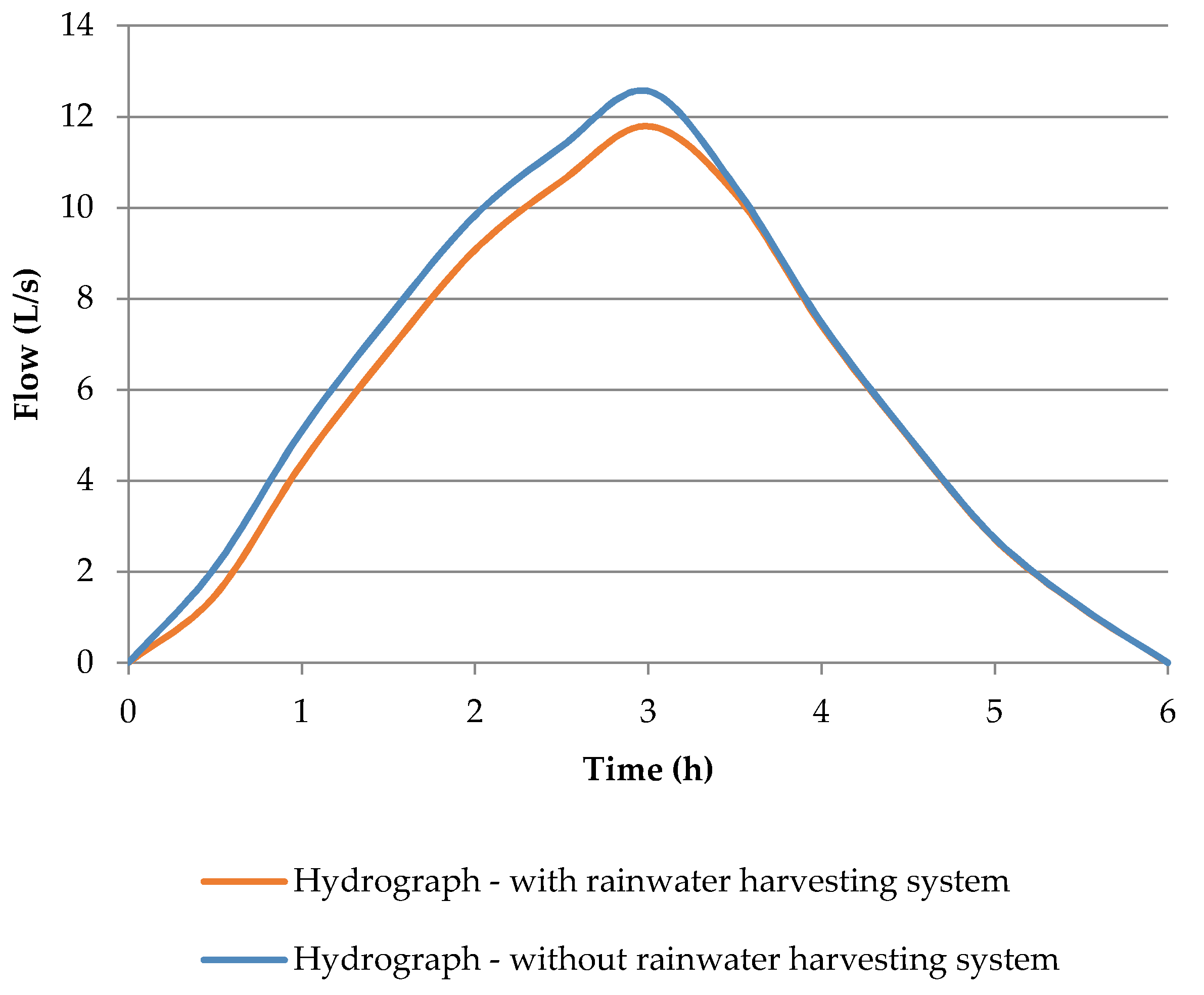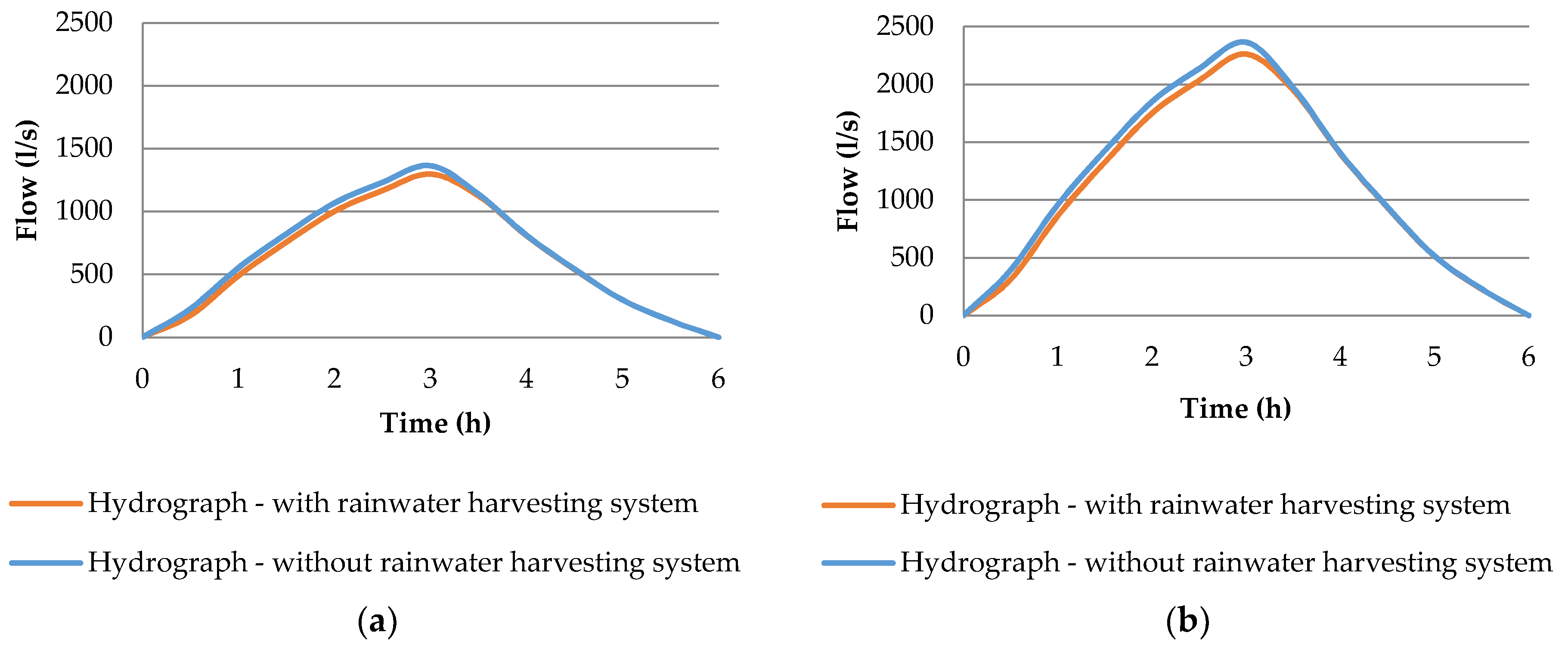Impact of Rainwater Harvesting on the Drainage System: Case Study of a Condominium of Houses in Curitiba, Southern Brazil
Abstract
:1. Introduction
- -
- Comparing tank design methods proposed by the Municipal Legislation of Curitiba and by the Brazilian Association of Technical Standards;
- -
- Evaluating the supply of nonpotable water;
- -
- Evaluating the reduction of surface runoff;
- -
- Evaluating the peak flow reduction for a critical precipitation event.
2. Method
2.1. Place of Study
- All lots were considered occupied by single-family houses;
- Each house was considered to have a rainwater harvesting system with an underground tank;
- Each house was considered to have a maximum floor plan area allowed by law, which means that the floor plan area of each house was equal to the area of the lot;
- The houses have 2, 3, or 4 bedrooms, depending on their floor plan area;
- The roof area and the projection of the house were considered equal, which equals 50% of the lots’ area;
- All lots maintained 25% of permeable area;
- The remaining 25% of the area is equivalent to the sidewalks.
2.2. Rainwater Demand
- Scenario 1: cleaning;
- Scenario 2: cleaning and washing floors (private sidewalks);
- Scenario 3: cleaning, washing floors, and flushing toilets.
2.3. Rainfall Data
2.4. Surface Flow Coefficient
2.5. Rainwater Tank Sizing
2.5.1. Usable Rainfall Volume
2.5.2. Municipal Decree of Curitiba 293/2006
2.5.3. NBR 15527/2007 Methods
2.6. System Efficiency and Reliability
2.7. Impact on Drainage
2.7.1. Scenario Without Rainwater Harvesting
2.7.2. Scenario with Rainwater Harvesting
2.7.3. Hydrographs Calculation
3. Results and Discussion
3.1. Rainwater Demand
- Scenario 1: 2.9% of the water demand (for cleaning);
- Scenario 2: 8.7% of the water demand (2.9% for cleaning and 5.8% for washing floors);
- Scenario 3: 23.7% of the water demand (2.9% for cleaning, 5.8% for washing floors, and 15% for flushing toilets).
3.2. Rainfall Data
3.3. Surface Flow Coefficients
3.4. Tanks Sizing
3.5. System Reliability
3.6. System Efficiency
3.7. Hydrographs Comparison
4. Conclusions
Author Contributions
Funding
Conflicts of Interest
References
- Poschen, P.; Iturriza, A.L.; Li, X.; Tobin, S.; Dessors, E.; Samaan, D.; Renner, M. Working Towards Sustainable Development: Opportunities for Decent Work and Social Inclusion in a Green Economy; International Labour Office: Genova, Italy, 2012. [Google Scholar]
- Bell, S. Renegotiating urban water. Prog. Plan. 2015, 96, 1–28. [Google Scholar] [CrossRef] [Green Version]
- Debusk, K.M.; Hunt, W.F.; Wright, J.D. Characterizing Rainwater Harvesting Performance and Demonstrating Stormwater Management Benefits in the Humid Southeast USA. J. Am. Water Resour. Assoc. 2013, 49, 1398–1411. [Google Scholar] [CrossRef]
- Ghisi, E. Parameters influencing the sizing of rainwater tanks. Water Resour. Manag. 2010, 24, 2381–2403. [Google Scholar] [CrossRef]
- Ghisi, E.; Montibeller, A.; Schmidt, R.W. Potential for potable water savings by using rainwater: An analysis over 62 cities in southern Brazil. Build. Environ. 2006, 41, 204–210. [Google Scholar] [CrossRef]
- Bezerra, S.M.C.; Christan, P.; Teixeira, C.A.; Farahbakhsh, K. Sizing rainwater harvesting reservoirs: A comparison between methods of ABNT NBR 15527:2007 and of Municipal Decree 293/2006 from the city of Curitiba, PR. Ambiente Construído 2010, 10, 219–231. (In Portuguese) [Google Scholar] [CrossRef]
- Berwanger, H.; Ghisi, E. Investment feasibility analysis of rainwater harvesting in the city of Itapiranga, Brazil. Int. J. Sustain. Hum. Dev. 2014, 2, 104–114. [Google Scholar]
- Zhang, D.; Gersberg, R.M.; Wilhelm, C.; Voigt, M. Decentralized water management: Rainwater harvesting and greywater reuse in an urban area of Beijing, China. Urban Water J. 2009, 6, 375–385. [Google Scholar] [CrossRef]
- Palla, A.; Gneco, I.; La Barbera, P. The impact of domestic rainwater harvesting systems in storm water runoff mitigation at the urban block scale. J. Environ. Manag. 2017, 191, 297–305. [Google Scholar] [CrossRef] [PubMed]
- Gee, K.D.; Hunt, W.F. Enhancing stormwater management benefits of rainwater harvesting via innovative technologies. J. Environ. Eng. 2016, 142, 04016039-1-11. [Google Scholar] [CrossRef]
- Herrmann, T.; Shmida, U. Rainwater utilization in Germany: Efficiency, dimensioning, hydraulic and environmental aspects. Urban Water 1999, 1, 307–316. [Google Scholar] [CrossRef]
- Kim, Y.; Kim, T.; Park, H.; Han, M. Design method for determining rainwater tank retention volumes to control runoff from building rooftops. KSCE J. Civ. Eng. 2014, 19, 1585–1590. [Google Scholar] [CrossRef]
- Zhang, X.; Hu, M.; Chen, G.; Xu, Y. Urban rainwater utilization and its role in mitigating urban waterlogging problems—A case study in Nanjing, China. Water Resour. Manag. 2012, 26, 3757–3766. [Google Scholar] [CrossRef]
- Steffen, J.; Jensen, M.; Pomeroy, C.A.; Burian, S.J. Water supply and stormwater management benefits of residential rainwater harvesting in U.S. cities. J. Am. Water Resour. Assoc. 2013, 49, 810–824. [Google Scholar] [CrossRef]
- Buffon, F.T. Rainwater Harvesting: Effect on the Urban Drainage System. Bachelor’s Thesis, Federal University of Rio Grande do Sul, Porto Alegre, Brazil, June 2010. [Google Scholar]
- Dornelles, F. Rainwater Use in the Urban Environment and Its Effect on Rainwater Drainage. Ph.D. Thesis, Federal University of Rio Grande do Sul, Porto Alegre, Brazil, October 2012. [Google Scholar]
- Ghisi, E.; Ferreira, D.F. Potential for potable water savings by using rainwater and greywater in a multi-storey residential building in southern Brazil. Build. Environ. 2007, 42, 2512–2522. [Google Scholar] [CrossRef]
- Tomaz, P. Aproveitamento de Água de Chuva: Aproveitamento de Água de Chuva Para Áreas Urbanas e Fins Não Potáveis, 2nd ed.; Navegar: São Paulo, Brazil, 2010. (In Portuguese) [Google Scholar]
- Tucci, C.E.M. Hydrology: Science and Application, 4th ed.; UFRGS/ABRH: Porto Alegre, Brazil, 2015. (In Portuguese) [Google Scholar]
- Associação Brasileira de Normas Técnicas (ABNT). Água da Chuva: Aproveitamento de Coberturas em áreas Urbanas Para Fins não Potáveis-Requisitos; Associação Brasileira de Normas Técnicas (ABNT): Rio de Janeiro, Brazil, 2007. (In Portuguese) [Google Scholar]
- Dispõe sobre os critérios do uso e conservação racional da água nas edificações e dá outras providências; Curitiba City Hall: Curitiba, Brazil, 28 March 2006. Decree No. 293. (In Portuguese)
- Cohim, E.; Garcia, A.; Kiperstok, A. Captação e aproveitamento de água de chuva: dimensionamento de reservatórios. In Proceedings of the IX Simpósio de Recursos Hídricos do Nordeste, Salvador, Brazil, 25–28 November 2008. (In Portuguese). [Google Scholar]
- Dornelles, F.; Tassi, R.; Goldenfum, J.A. Evaluation of the Dimensioning Techniques for Rainwater Harvesting Tanks. Braz. J. Water Resour. 2010, 15, 59–68. (In Portuguese) [Google Scholar] [CrossRef]
- Giacchini, M.; Andrade, A.G.F. Study on the method the days without rain for the tanks sizing. J. Eng. Technol. 2011, 3, 36–43. (In Portuguese) [Google Scholar]
- Gomes, J.; Weber, D.C.; Delong, M.D. Tank Design for Rainwater use Based on a Financial Criterion. Braz. J. Water Resour. 2010, 15, 89–100. [Google Scholar] [CrossRef]
- Silveira, A.L.L. Performance of time of concentration formulas for urban and rural basins. Braz. J. Water Resour. 2005, 10, 5–29. (In Portuguese) [Google Scholar] [CrossRef]
- May, S. Feasibility Study for the Use of Rainwater for Nonpotable Consumption in Buildings. Master’s Thesis, University of São Paulo, São Paulo, Brazil, June 2004. (In Portuguese). [Google Scholar]
- Carvalho, D.F. Manejo e conservação do solo e da água. 2013. UFRRJ—Prof. Daniel Fonseca de Carvalho, D.Sc. Available online: http://www.ufrrj.br/institutos/it/deng/daniel/ia1311-Manejo.htm (accessed on 16 August 2018).
- Alessi, F.; Kokot, P.J.; Gomes, J. Comparison of surface runoff generated by permeable pavements in concrete blocks and porous asphalt. Da Vinci 2006, 3, 139–156. [Google Scholar]
- Geraldi, M.S.; Ghisi, E. Influence of the length of rainfall time series on rainwater harvesting systems: A case study in Berlin. Resour. Conserv. Recycl. 2017, 125, 169–180. [Google Scholar] [CrossRef]
- Tassi, R. Effect of Batch Micro-Reservoir on Urban Macrodrainage. Master’s Thesis, Federal University of Rio Grande do Sul, Porto Alegre, Brazil, December 2002. (In Portuguese). [Google Scholar]
- Zahmatkesh, Z.; Burian, S.J.; Karamouz, M.; Tavakol-Davani, H.; Goharian, E. Low-impact development practices to mitigate climate change effects on urban stormwater runoff: Case study of New York City. J. Irrig. Drain. Eng. 2015, 141, 4014043-1-13. [Google Scholar] [CrossRef]






| Year | Maximum Number of Days without Rain | Annual Rainfall (mm) |
|---|---|---|
| 1997 | 13 | - |
| 1998 | 16 | 1824.8 |
| 1999 | 13 | 1412.0 |
| 2000 | 17 | 1385.6 |
| 2001 | 14 | 1567.6 |
| 2002 | 14 | 1383.8 |
| 2003 | 18 | 1189.0 |
| 2004 | 33 | 1191.2 |
| 2005 | 14 | 1333.2 |
| 2006 | 17 | 932.8 |
| 2007 | 38 | 1252.6 |
| 2008 | 28 | 1198.6 |
| 2009 | 10 | 1664.6 |
| 2010 | 23 | 1776.8 |
| 2011 | 21 | 1858.4 |
| 2012 | 25 | 1483.8 |
| 2013 | 13 | - |
| Average | 19 | 1430.3 |
| Surfaces | Percentage of Occupied Area (%) | Type of Coating | Runoff Coefficient | Source |
|---|---|---|---|---|
| Roofs | 26.0 | Ceramic tiles | 0.85 | [27] |
| Streets | 13.8 | Asphalt | 0.95 | [28] |
| Common sidewalks | 12.9 | Paver | 0.58 | [29] |
| Private sidewalks | 12.7 | Concrete | 0.95 | [28] |
| Lawn gardens | 17.2 | Grass/silt clay with slope of 5 to 10% | 0.55 | [28] |
| Permanent preservation area | 14.1 | Native vegetation | 0.50 | [28] |
| Scenario | Tank Capacities (L) | |||||
|---|---|---|---|---|---|---|
| German Practical (22 days) | Decree 293 | 19 Days (K = 0.054) | 26 Days (K = 0.071) | 30 Days (K = 0.082) | 35 Days (K = 0.096) | |
| 1 | 632 | 500 | 568 | 747 | 863 | 1011 |
| 2 | 1262 | 500 | 1135 | 1493 | 1724 | 2019 |
| 3 | 4547 | 500 | 4092 | 5380 | 6214 | 7275 |
| Scenario | Tank Capacities (L) | |||||
|---|---|---|---|---|---|---|
| German Practical (22 days) | Decree 293 | 19 Days (K = 0.054) | 26 Days (K = 0.071) | 30 Days (K = 0.082) | 35 Days (K = 0.096) | |
| 1 | 500 | 500 | 500 | 500 | 1000 | 1000 |
| 2 | 1500 | 500 | 1000 | 1500 | 1500 | 2000 |
| 3 | 4500 | 500 | 4000 | 5500 | 6000 | 7500 |
| Scenario | Rainwater Demand (%) | Potential for Potable Water Savings (%) | |||||
|---|---|---|---|---|---|---|---|
| Decree 293 | 19 Days (K = 0.054) | 22 Days (German Practical) | 26 Days (K = 0.071) | 30 Days (K = 0.082) | 35 Days (K = 0.096) | ||
| 1 | 2.9 | 2.8 | 2.8 | 2.8 | 2.8 | 2.9 | 2.9 |
| 2 | 5.8 | 4.9 | 5.5 | 5.6 | 5.6 | 5.6 | 5.7 |
| 3 | 20.8 | 9.2 | 18.3 | 18.6 | 19.1 | 19.2 | 19.7 |
| Total Precipitation—P (mm) | Accumulated Precipitation (mm) | Curve Number—CN | Maximum Potential Infiltration—S (mm) | Initial Infiltration—P𝒂 (mm) | Cumulative Surplus Precipitation—Pe (mm) | Surplus Precipitation (mm) |
|---|---|---|---|---|---|---|
| 31.64 | 31.64 | 92 | 22.09 | 4.42 | 15.03 | 15.03 |
| 24.86 | 56.50 | 92 | 22.09 | 4.42 | 36.57 | 21.54 |
| 19.21 | 75.71 | 92 | 22.09 | 4.42 | 54.43 | 17.86 |
| 16.95 | 92.66 | 92 | 22.09 | 4.42 | 70.58 | 16.15 |
| 11.30 | 103.96 | 92 | 22.09 | 4.42 | 81.47 | 10.89 |
| 9.04 | 113.00 | 92 | 22.09 | 4.42 | 90.23 | 8.76 |
© 2018 by the authors. Licensee MDPI, Basel, Switzerland. This article is an open access article distributed under the terms and conditions of the Creative Commons Attribution (CC BY) license (http://creativecommons.org/licenses/by/4.0/).
Share and Cite
Teston, A.; Teixeira, C.A.; Ghisi, E.; Cardoso, E.B. Impact of Rainwater Harvesting on the Drainage System: Case Study of a Condominium of Houses in Curitiba, Southern Brazil. Water 2018, 10, 1100. https://doi.org/10.3390/w10081100
Teston A, Teixeira CA, Ghisi E, Cardoso EB. Impact of Rainwater Harvesting on the Drainage System: Case Study of a Condominium of Houses in Curitiba, Southern Brazil. Water. 2018; 10(8):1100. https://doi.org/10.3390/w10081100
Chicago/Turabian StyleTeston, Andréa, Celimar Azambuja Teixeira, Enedir Ghisi, and Ernani Benincá Cardoso. 2018. "Impact of Rainwater Harvesting on the Drainage System: Case Study of a Condominium of Houses in Curitiba, Southern Brazil" Water 10, no. 8: 1100. https://doi.org/10.3390/w10081100





